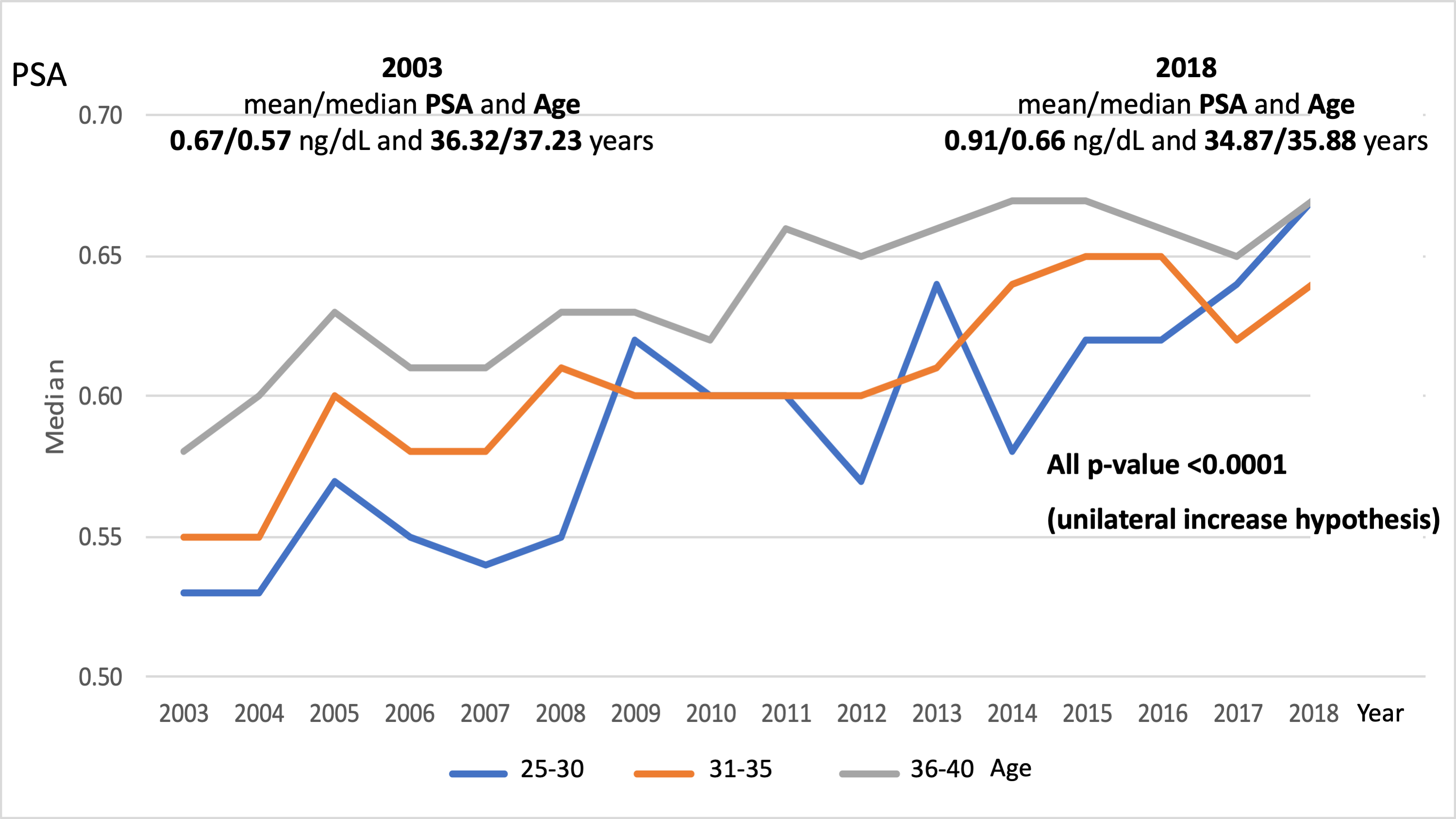Back
Poster, Podium & Video Sessions
Prostate Cancer: Epidemiology & Natural History II
PD13-02: Age‑independent secular baseline PSA population trends among young Latin American males
Friday, May 13, 2022
3:40 PM – 3:50 PM
Location: Room 252
Diego M. Capibaribe, Walker W. Laranja, Wilmar Azal Neto, Danilo L. Andrade, Rodrigo G. Bocos, Natássia C. C. Truzzi, Campinas, Brazil, José C.C.I. Truzzi, Sao Paulo;, Brazil, Leonardo Reis*, Campinas, Brazil

Leonardo O. Reis, MD, PHD, MSC
Pontifical Catholic University of Campinas - PUC-Campinas, Brazil
Podium Presenter(s)
Introduction: To broaden the understanding of possible baseline PSA variations over the last decades in young men.
Methods: PSA levels from 46,709 patients from a private diagnostic center aging 25 to 40 years old were prospectively collected between 2003 and 2018 in Brazil. Patients were distributed into three age groups (Group 1: 25-30 years, Group 2: 31-35 years, Group 3: 36-40 years). Data were analyzed using the Jonckheere–Terpstra with post hoc analysis and ANOVA with Tukey post hoc tests to rank values and establish upwards or downwards trends.
Results: Mean participant age and total PSA were 35.64 years and 0.77ng/dL, respectively. The mean/median age among PSA-tested men decreased from 36.32/37.23 in 2003 to 34.87/35.88 years old in 2018. On the contrary, the mean/median PSA values rose from 0.67/0.57 ng/dL in 2003 to 0.91/0.66 ng/dL in 2018, with a steady increase over the studied period at a rate of 0.015ng/dL of the median per year, p<0.0001. The PSA increase rate was 0.016 ng/dL per year (2.8%) in Group 1, 0.015 ng/dL (2.2%) in Group 2 and 0.017ng/dL (2.5%) rise per year in Group 3, all p<0.0001.
Conclusions: Mean participant age and total PSA were 35.64 years and 0.77ng/dL, respectively. The mean/median age among PSA-tested men decreased from 36.32/37.23 in 2003 to 34.87/35.88 years old in 2018. On the contrary, the mean/median PSA values rose from 0.67/0.57 ng/dL in 2003 to 0.91/0.66 ng/dL in 2018, with a steady increase over the studied period at a rate of 0.015ng/dL of the median per year, p<0.0001. The PSA increase rate was 0.016 ng/dL per year (2.8%) in Group 1, 0.015 ng/dL (2.2%) in Group 2 and 0.017ng/dL (2.5%) rise per year in Group 3, all p<0.0001.
Source of Funding: none

Methods: PSA levels from 46,709 patients from a private diagnostic center aging 25 to 40 years old were prospectively collected between 2003 and 2018 in Brazil. Patients were distributed into three age groups (Group 1: 25-30 years, Group 2: 31-35 years, Group 3: 36-40 years). Data were analyzed using the Jonckheere–Terpstra with post hoc analysis and ANOVA with Tukey post hoc tests to rank values and establish upwards or downwards trends.
Results: Mean participant age and total PSA were 35.64 years and 0.77ng/dL, respectively. The mean/median age among PSA-tested men decreased from 36.32/37.23 in 2003 to 34.87/35.88 years old in 2018. On the contrary, the mean/median PSA values rose from 0.67/0.57 ng/dL in 2003 to 0.91/0.66 ng/dL in 2018, with a steady increase over the studied period at a rate of 0.015ng/dL of the median per year, p<0.0001. The PSA increase rate was 0.016 ng/dL per year (2.8%) in Group 1, 0.015 ng/dL (2.2%) in Group 2 and 0.017ng/dL (2.5%) rise per year in Group 3, all p<0.0001.
Conclusions: Mean participant age and total PSA were 35.64 years and 0.77ng/dL, respectively. The mean/median age among PSA-tested men decreased from 36.32/37.23 in 2003 to 34.87/35.88 years old in 2018. On the contrary, the mean/median PSA values rose from 0.67/0.57 ng/dL in 2003 to 0.91/0.66 ng/dL in 2018, with a steady increase over the studied period at a rate of 0.015ng/dL of the median per year, p<0.0001. The PSA increase rate was 0.016 ng/dL per year (2.8%) in Group 1, 0.015 ng/dL (2.2%) in Group 2 and 0.017ng/dL (2.5%) rise per year in Group 3, all p<0.0001.
Source of Funding: none


.jpg)
.jpg)